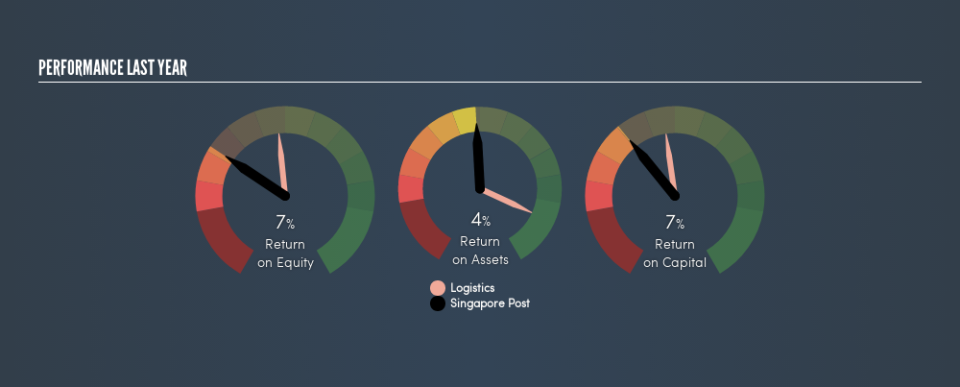Why We’re Not Keen On Singapore Post Limited’s (SGX:S08) 7.3% Return On Capital

Today we’ll look at Singapore Post Limited (SGX:S08) and reflect on its potential as an investment. To be precise, we’ll consider its Return On Capital Employed (ROCE), as that will inform our view of the quality of the business.
First, we’ll go over how we calculate ROCE. Then we’ll compare its ROCE to similar companies. Finally, we’ll look at how its current liabilities affect its ROCE.
Understanding Return On Capital Employed (ROCE)
ROCE measures the amount of pre-tax profits a company can generate from the capital employed in its business. All else being equal, a better business will have a higher ROCE. Ultimately, it is a useful but imperfect metric. Author Edwin Whiting says to be careful when comparing the ROCE of different businesses, since ‘No two businesses are exactly alike.’
So, How Do We Calculate ROCE?
Analysts use this formula to calculate return on capital employed:
Return on Capital Employed = Earnings Before Interest and Tax (EBIT) ÷ (Total Assets – Current Liabilities)
Or for Singapore Post:
0.073 = S$145m ÷ (S$2.7b – S$668m) (Based on the trailing twelve months to December 2018.)
Therefore, Singapore Post has an ROCE of 7.3%.
View our latest analysis for Singapore Post
Does Singapore Post Have A Good ROCE?
When making comparisons between similar businesses, investors may find ROCE useful. We can see Singapore Post’s ROCE is meaningfully below the Logistics industry average of 9.6%. This performance is not ideal, as it suggests the company may not be deploying its capital as effectively as some competitors. Setting aside the industry comparison for now, Singapore Post’s ROCE is mediocre in absolute terms, considering the risk of investing in stocks versus the safety of a bank account. Readers may find more attractive investment prospects elsewhere.
Singapore Post’s current ROCE of 7.3% is lower than 3 years ago, when the company reported a 11% ROCE. Therefore we wonder if the company is facing new headwinds.
When considering this metric, keep in mind that it is backwards looking, and not necessarily predictive. Companies in cyclical industries can be difficult to understand using ROCE, as returns typically look high during boom times, and low during busts. ROCE is, after all, simply a snap shot of a single year. What happens in the future is pretty important for investors, so we have prepared a free report on analyst forecasts for Singapore Post.
Do Singapore Post’s Current Liabilities Skew Its ROCE?
Liabilities, such as supplier bills and bank overdrafts, are referred to as current liabilities if they need to be paid within 12 months. Due to the way the ROCE equation works, having large bills due in the near term can make it look as though a company has less capital employed, and thus a higher ROCE than usual. To counter this, investors can check if a company has high current liabilities relative to total assets.
Singapore Post has total assets of S$2.7b and current liabilities of S$668m. Therefore its current liabilities are equivalent to approximately 24% of its total assets. This very reasonable level of current liabilities would not boost the ROCE by much.
The Bottom Line On Singapore Post’s ROCE
With that in mind, we’re not overly impressed with Singapore Post’s ROCE, so it may not be the most appealing prospect. You might be able to find a better buy than Singapore Post. If you want a selection of possible winners, check out this free list of interesting companies that trade on a P/E below 20 (but have proven they can grow earnings).
If you like to buy stocks alongside management, then you might just love this free list of companies. (Hint: insiders have been buying them).
We aim to bring you long-term focused research analysis driven by fundamental data. Note that our analysis may not factor in the latest price-sensitive company announcements or qualitative material.
If you spot an error that warrants correction, please contact the editor at editorial-team@simplywallst.com. This article by Simply Wall St is general in nature. It does not constitute a recommendation to buy or sell any stock, and does not take account of your objectives, or your financial situation. Simply Wall St has no position in the stocks mentioned. Thank you for reading.

